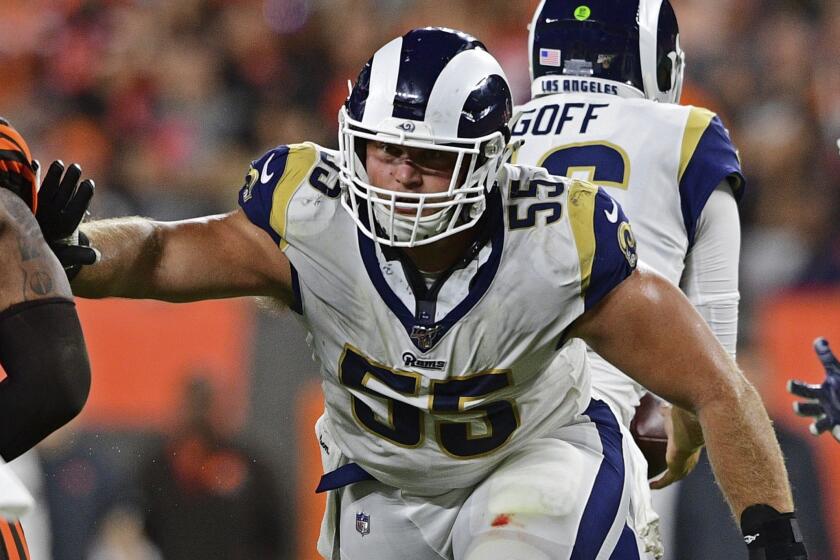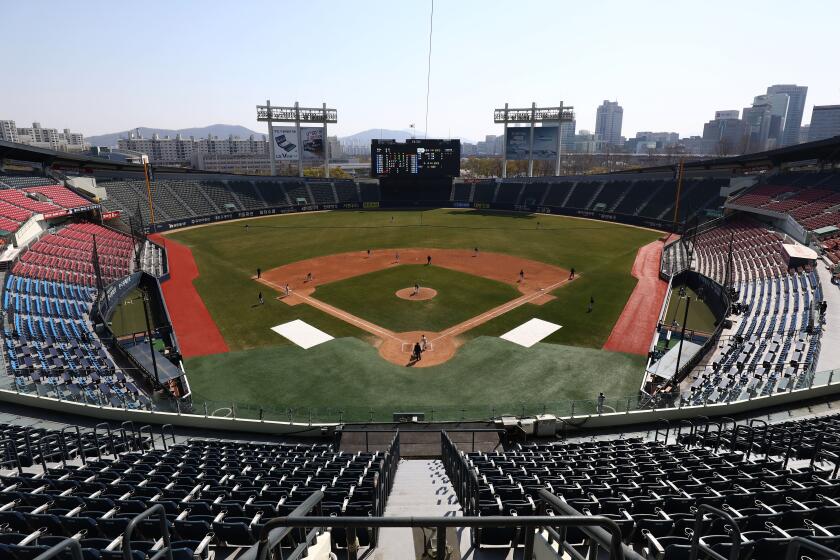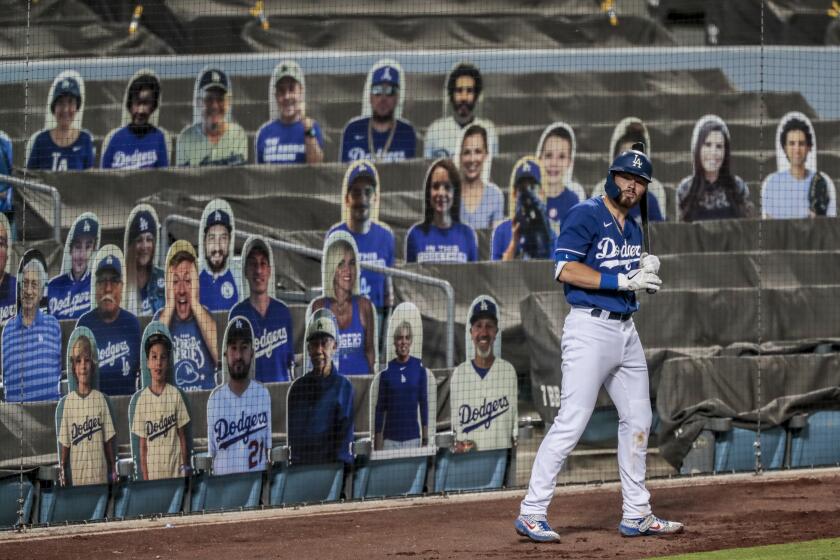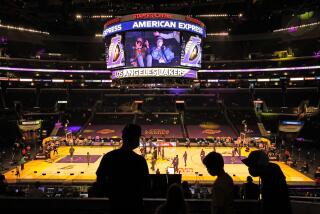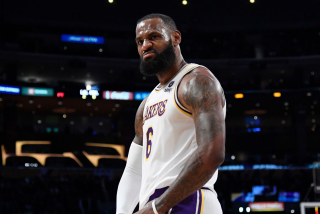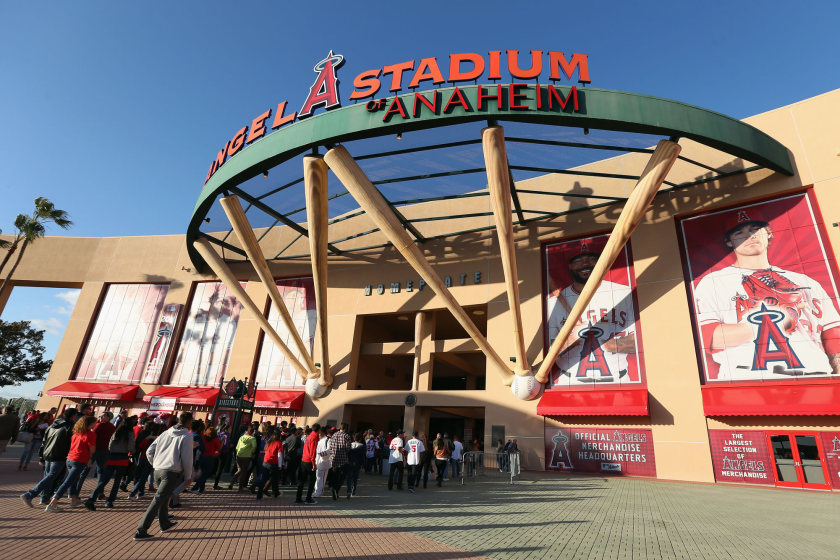Half of NBA and NHL coronavirus cases are linked to Staples Center. What happened?
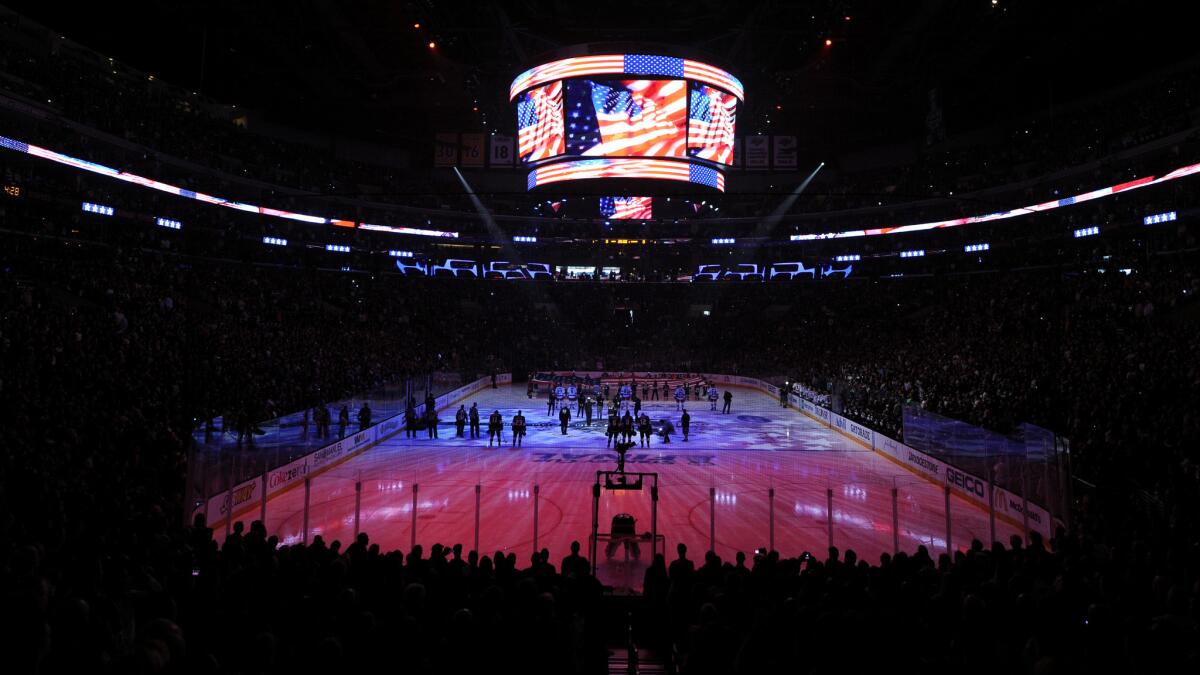
- Share via
The NBA’s reach extends across the globe, broadcasting to more than 200 countries and territories while generating almost $9 billion in annual revenue. Its top players are the most powerful in sports, able to reach tens of millions and spark change with a single social media post. The behemoth’s reach and influence across cultures and time zones is built on a massive sum of interconnected parts.
It is a fragile behemoth too, those same woven connections vulnerable to the chain reactions upon which a pandemic preys.
However, a pandemic didn’t seem to be on the minds of players as recently as the first week of March, when the insouciance of the NBA mirrored that of sports at large and the rest of the country.
The games went on, with the usual casual human contact: hugs, high-fives, news conferences in cramped locker rooms, charter flights, hotel stays. Life went on, with grocery shelves still filled with cans of beans, bags of pasta, toilet paper. The spread of the novel coronavirus, which had reached the front pages, nonetheless still felt like someone else’s problem.
Behind the scenes, though, tension mounted. The league issued a series of increasingly alarming memorandums. Limit interactions with fans. Increase reminders to fans to wash their hands. Use fist-bumps instead of high-fives. Prepare to play games with only essential personnel present.
Staples Center, home to the Lakers and Clippers and the NHL’s Kings, ramped up cleaning procedures as part of a wide-ranging plan. The hub of sports and entertainment in Los Angeles hosted 39 events after the first case of COVID-19 was diagnosed in the county, including the memorial service for Kobe Bryant, the Grammy Awards, two nights of bull riding, 12 Kings games, and 19 games involving the Lakers or Clippers.
The final three games came during four days, ending March 11 when sports at every level lurched to a stop because the rampant spread of the virus had reached NBA locker rooms.
At least eight athletes who played in those games have been diagnosed with COVID-19: four Brooklyn Nets, including sidelined star Kevin Durant, two Lakers who haven’t been identified and two members of the NHL’s Ottawa Senators. Identifying the source and site of the infection is impossible, but the Lakers’ schedule during that final week put them within four degrees of separation of every NBA team. The crossover between leagues — 11 arenas are home to both NBA and NHL teams — the densely loaded schedules, the proximity to closely packed stands, combined with an easily spread virus, created a new label for athletes: super spreaders.
Amid the tumult of sports at every level shutting down, followed by much of the country, Staples Center is a common denominator among eight of the 16 cases of COVID-19 announced by NBA and NHL teams.
This is the story of the last four days inside Staples Center.
::
By the time the Lakers faced the Clippers on March 8, a Sunday, the NBA had already circulated a memo to arena general managers encouraging them to assemble a COVID-19 working group, increase reminders to fans about personal hygiene and suggesting a range of measures to ensure the cleanliness of their buildings like sanitizing cash registers and door handles.
Staples Center, which hosts about 250 events each year and has up to 1,700 part-time employees at games, installed 120 hand-sanitizing stations throughout the arena, including locker rooms, on March 1. Enhanced cleaning procedures followed. Eighty-five additional staffers were brought in for postgame cleaning. Areas that visitors or staff touch were cleaned regularly: ATMs, doorknobs, elevator buttons, escalator rails, food service areas, point-of-sale terminals, restrooms. Even telephones in the luxury suites. The arena purchased disinfectant products and new equipment to minimize the spread of germs in its five locker rooms, 48 restrooms and slew of other private and public areas.
A look at athletes, coaches and others in the sports world who have tested positive of the coronavirus.
The Clippers eliminated a tradition where players slapped hands with fans while running onto the court before tipoff.
Though the NBA had circulated at least two additional memos related to COVID-19 precautions — including one March 7 instructing teams to identify a site that could test for the virus and to distribute hand sanitizer to all players and staff — the looming crisis remained fodder for some kidding around.
During the game against the Clippers, Lakers star Anthony Davis appeared to lick his hand and high-five teammates LeBron James and Avery Bradley. Teammates jokingly dubbed them “The Corona Boys.” Davis insisted he hadn’t licked his hand.
“I kind of like mimicked it and it was like this whole thing,” Davis said. “I’m cleaner than that.”
Several Senators hockey players attended the game, reportedly in a suite, as the Lakers defeated the Clippers in what looked like a preview of the Western Conference finals.
::
Two days later, on March 10, fans squeezed through the doors at Staples Center before the Lakers played the Nets. Even though the first case of COVID-19 from community spread in L.A. County had been announced earlier in the afternoon, everything at the arena appeared normal. Some fans stopped at hand-sanitizing stations. Others didn’t.
Though 20 cases of the virus had been diagnosed in the county, fans shrugged off talk about playing games without spectators.
“It’s been blown out of proportion,” one said of the virus.
Local reporters embraced DeAndre Jordan, a former Clipper now with the Nets, and Jared Dudley of the Lakers on the court before the game.
But there were hints that all wasn’t right.
Staples Center added attendants in each restroom to continually disinfect surfaces.
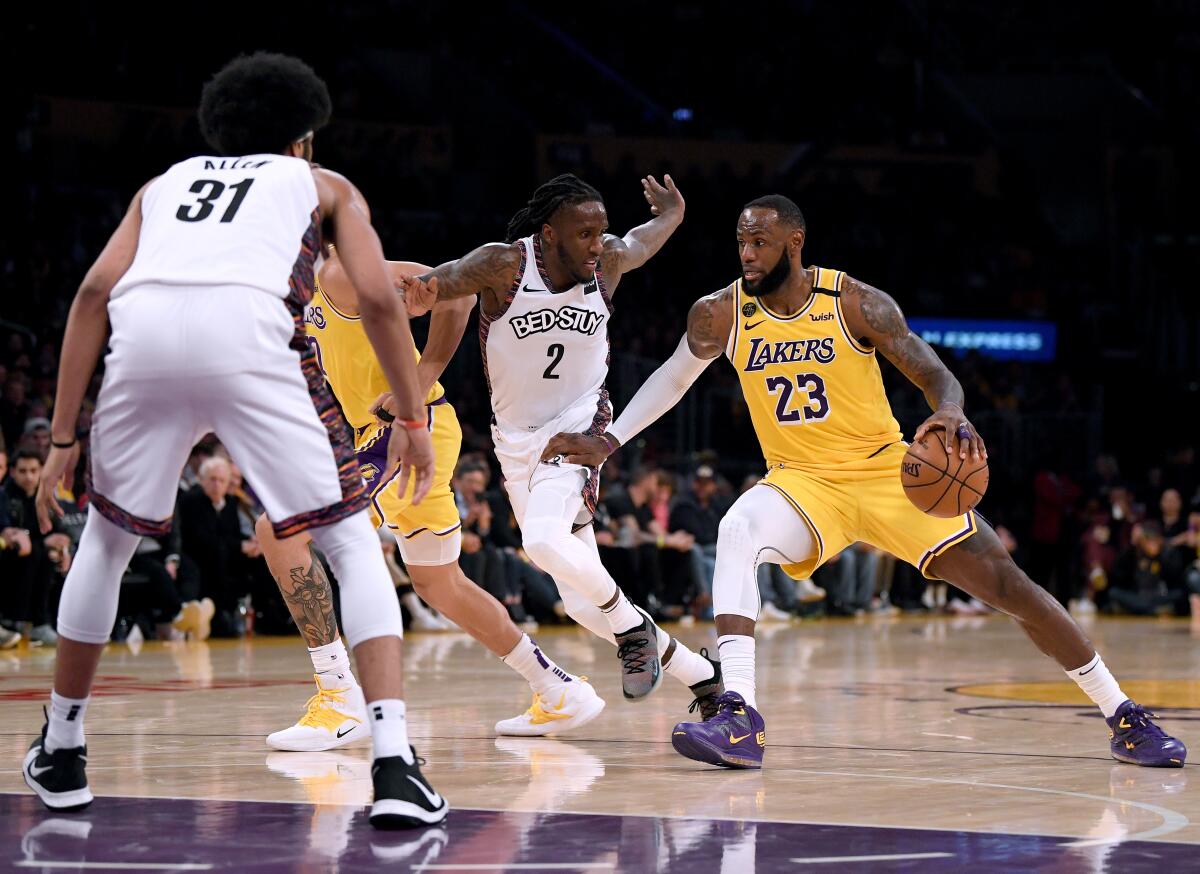
The NBA, along with Major League Baseball, the NHL and Major League Soccer, had limited locker room access to essential personnel and mandated that interviews be conducted with six feet between media members and players. What qualified as “essential” remained broad: executives, equipment staffers, media relations staffers, support staffers.
Jacque Vaughn, the Nets coach, told reporters he wasn’t worried about COVID-19.
For pregame and postgame Lakers news conferences, dozens of reporters crammed into the locker room used by visiting hockey teams. The Senators would use the room a day later. Black curtains covered the lockers. About 30 chairs in the room for media members were so close together that they touched. Some journalists stood next to walls. But Lakers coach Frank Vogel and players maintained a six-foot distance from media members.
After a two-point loss to the Nets, Lakers player Danny Green was asked if he had changed anything to deal with the virus.
“Some guys have, some guys haven’t,” he said. “It doesn’t really matter to me. I haven’t. I still sign autographs. I still fist bump, shake hands, say ‘what’s up.’ Extra sanitizer, but that’s not a focus right now. Just continue to focus on playing basketball. Just have to adjust to whatever comes.”
::
The next day, March 11, the World Health Organization declared the virus to be a pandemic.
The NCAA announced March Madness games would be played without fans. Several professional teams, including the Golden State Warriors, did the same.
President Trump addressed the nation and limited travel with Europe.
A look at how sports leagues, including the NFL, MLB, MLS, NBA and NHL, are responding to the coronavirus outbreak.
Meanwhile, the Kings and Senators prepared to play hockey at Staples Center. About an hour before the scheduled start, the NBA announced it would suspend its season after Utah Jazz player Rudy Gobert tested positive for COVID-19 before the team’s game in Oklahoma City.
“I think people are taking enough precautions, and I am myself too, so I’m not particularly concerned,” one fan said.
A member of the Kings front office surveyed the tiny crowd — just 12,030 fans showed up, by far the smallest of the season — and wondered where everyone was.
The Kings, in keeping with new regulations to keep media members out of locker rooms, held their postgame news conference in the locker room the Nets used the previous night. The main concern was whether the NHL season would continue — the league suspended play the next day — not whether players or staffers were infected with COVID-19.
“The night felt strange,” Kings coach Todd McLellan said.
::
Gobert and Donovan Mitchell of the Jazz and Christian Wood of the Detroit Pistons were the only NBA players who had tested positive for COVID-19 before the announcement last Tuesday that shook the league.
Four members of the Nets had tested positive. Durant, the 10-time All-Star who is out for the season while rehabbing a torn Achilles tendon, was the only player to confirm he had it.
“Public health authorities and team doctors have been concerned that, given NBA players’ direct contact with each other and close interactions with the general public, in addition to their frequent travel, they could accelerate the spread of the virus,” an NBA spokesman said in response to questions about why players received tests when they are in short supply across the country.
The same day, the Senators announced an unidentified player had also tested positive, the first to do so in the NHL.
However, the Senators and Nets had not used the same spaces at Staples Center and took different routes to the arena floor. The only time their footsteps would have been the same is the walk from the team bus through the marshaling area and to the corridor where the locker rooms are located.
There wasn’t any “cross-pollination” between the Senators and Nets at Staples Center, according to Lee Zeidman, president of the arena, the Microsoft Theater and L.A. Live, because they didn’t use the same facilities.
Stories examining the impact the spread of the coronavirus has had on the NBA, NHL, MLB, the NCAA tournament and the rest of the sports world.
On Wednesday morning, 14 Lakers players were tested for COVID-19 at the team’s facility in El Segundo. Team physicians and public health officials recommended the move after the positive tests by the Nets. A season aimed at a championship had degenerated into a 10-second procedure where a large swab was inserted up noses and twisted around.
The two positive results were announced the next day. Neither player has been identified, but the Lakers said both are asymptomatic and quarantined.
The stream of results continued Saturday when a second Senators player tested positive. Of the 52 players and staff who joined the team’s California trip that included stops in San Jose and Anaheim, eight have been tested. More results are pending. Last week, the team directed all members of the traveling party to self-quarantine.
No members of the Kings or Clippers have tested positive for COVID-19. But the eight positive tests by athletes with recent games at Staples Center are a tiny piece of the mushrooming public health crisis that has grown to more than 26,000 cases and 260 deaths from the coronavirus in the U.S.
While much of the country stays home to try to halt the spread of COVID-19 — beleaguered by lost jobs, destroyed routines and pervasive uncertainty — the games feel like a hazy memory. But the question, one among many, still lingers around the final four days at Staples Center. With so many precautions, how did this happen?
That might never be known. The virus could have been transmitted just as easily in a team bus or charter flight or another arena or a thousand other places. The people involved will have to ponder the question in the same place as most everyone else. Home.
Staff writers Helene Elliott, Tania Ganguli, Andrew Greif, Jack Harris, Broderick Turner and Dan Woike contributed to this report.
More to Read
Go beyond the scoreboard
Get the latest on L.A.'s teams in the daily Sports Report newsletter.
You may occasionally receive promotional content from the Los Angeles Times.
